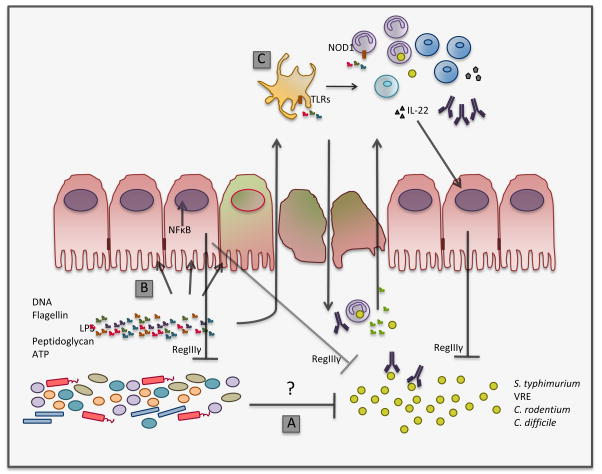Figure 1.
Major mechanisms that may contribute to the restoration of colonization resistance. Antibiotic treatment results in depletion of the normal microbiota, rendering the host susceptible to colonization by potentially pathogenic microbes. Recovery of a commensal microbiota by adoptive transfer or cohousing with normal mice restores colonization resistance, leading to clearance of dangerous bacteria such as S. typhimurium and VRE. Two major mechanisms may contribute to pathogen clearance: the direct effect of the commensal flora on the growth of the pathogen (A) and restoration of immune tone induced by stimulation of immune receptors, preventing expansion of the pathogen (B and C). The mechanisms underlying direct pathogen inhibition by the microbiota remain ill-defined, but may include competition for nutritional resources and production of growth inhibitory molecules. As depicted in B, bacterial products stimulate innate immune receptors expressed on epithelial cells to restore immune homeostasis in the intestine. The production of RegIIIγ, an antimicrobicidal lectin that targets Gram-positive bacteria, by intestinal epithelial cells, helps maintain homeostasis of intestinal microbial communities and contributes to clearance of invading species such as VRE. RegIIIγ is elicited by direct sensing of the microbiota by intestinal epithelial cells (B) or, when bacterial products are found systemically, by sensing of bacterial products by cells of hematopoietic origin that express IL-22 (C). Following disruption of the epithelium, bacteria and their products reach the lamina propria and stimulate innate immune receptors, which recruits and activates neutrophils and monocytes, and stimulates IgA responses (C). Immune cells of the lamina propria are activated to generate an antimicrobial program that clears the pathogen and restores health to the epithelial barrier.

